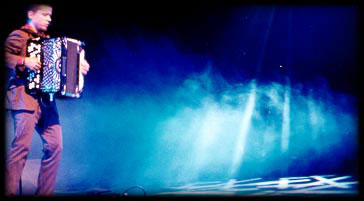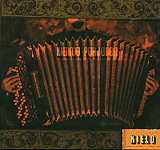Kimmo Pohjonen
An interview by Heather Henderson


"It's not people's fault that they don't like the accordion!" declares Kimmo Pohjonen. "It's the musicians! If they do good music, then people will find the instrument. It all has to come from the music." This Finnish musician presents his case with the same passion that he puts into his music, whether it's rock, folk, or his own groundbreaking compositions.
"Zwack" |
 The day after one of these grueling performances, he's bursting with energy. His gestures are as expressive as his words: in the middle of a story, he'll spring up out of his chair to act out a scene, mimic a character, or demonstrate a dance movement. He's nothing like the stereotype of the dour, stodgy Finn. Rather, his liveliness and humor suggest a Nordic version of Robin Williams. But he's never fit any of the stereotypes, starting with his attraction to the accordion at the age of ten. "I was the only young guy at that time, in the '70s, who really liked this weird instrument. I couldn't tell it to my friends, because people at that time HATED the accordion � they thought it was an instrument which only old people played." In Finland, as in the US, the image of the accordion had been ruined by its association with schmaltzy oom-pah music. Even so, Pohjonen felt that there was something more to it. He stuck with the instrument and studied it for years, in spite of his struggles with narrow-minded instructors. "In school they're saying, 'Don't do it like this, play like THIS!'" he says. "I got such a traumatic thing from my teachers. It took a long time to get out of that. I had so many rules in my head about how I should play." Then, by chance, he attended a concert by young students from the Sibelius Academy's folk department, where innovation and improvisation were encouraged. It was a life-changing experience. He joined the Academy, where he found the freedom to express himself.
The day after one of these grueling performances, he's bursting with energy. His gestures are as expressive as his words: in the middle of a story, he'll spring up out of his chair to act out a scene, mimic a character, or demonstrate a dance movement. He's nothing like the stereotype of the dour, stodgy Finn. Rather, his liveliness and humor suggest a Nordic version of Robin Williams. But he's never fit any of the stereotypes, starting with his attraction to the accordion at the age of ten. "I was the only young guy at that time, in the '70s, who really liked this weird instrument. I couldn't tell it to my friends, because people at that time HATED the accordion � they thought it was an instrument which only old people played." In Finland, as in the US, the image of the accordion had been ruined by its association with schmaltzy oom-pah music. Even so, Pohjonen felt that there was something more to it. He stuck with the instrument and studied it for years, in spite of his struggles with narrow-minded instructors. "In school they're saying, 'Don't do it like this, play like THIS!'" he says. "I got such a traumatic thing from my teachers. It took a long time to get out of that. I had so many rules in my head about how I should play." Then, by chance, he attended a concert by young students from the Sibelius Academy's folk department, where innovation and improvisation were encouraged. It was a life-changing experience. He joined the Academy, where he found the freedom to express himself.
 Since then, he's become a master of different instruments, including the two-row accordion, various harmonicas, and the gogo marimba (Tanzanian thumb piano). He's also a fine singer. As a member of "new folk" groups Pinnin Pojat and Ottopasuuna, he has demonstrated his skills as both musician and composer. Last year he released his own solo CD, Kielo, which has received great reviews even from people who aren't interested in accordion music. Its unique style is hard to classify. It's not quite jazz, though it has an improvisational feel, and while it challenges the listener's expectations on many levels, the music is accessible and often very beautiful. "In a way, it's not an accordion record," Pohjonen says. "It's a music record. I don't think of myself as an accordion player, even though I AM an accordion player � I'm a musician who makes music."
Since then, he's become a master of different instruments, including the two-row accordion, various harmonicas, and the gogo marimba (Tanzanian thumb piano). He's also a fine singer. As a member of "new folk" groups Pinnin Pojat and Ottopasuuna, he has demonstrated his skills as both musician and composer. Last year he released his own solo CD, Kielo, which has received great reviews even from people who aren't interested in accordion music. Its unique style is hard to classify. It's not quite jazz, though it has an improvisational feel, and while it challenges the listener's expectations on many levels, the music is accessible and often very beautiful. "In a way, it's not an accordion record," Pohjonen says. "It's a music record. I don't think of myself as an accordion player, even though I AM an accordion player � I'm a musician who makes music."
In his solo concerts, he uses an instantaneous electronic playback system to build layers of sound, weaving musical threads together to create impressionistic soundscapes. Often he adds his wordless vocals to the mix. He also uses the mechanism of the accordion to make effects � in one piece, "Silm�ys", the "breathing" of the bellows becomes the ebb and flow of ocean waves. This sound system has opened up his experience of the accordion and has enabled him to be daringly inventive. "The accordion is an acoustic instrument, so using the sound system I've been finding so many new things that I wouldn't have found before. It's giving more space, more new sounds. Very often, people think that I have background tapes, but I do everything live, and all the sound is coming from the accordion. And some sounds are so unfamiliar to them that they can't accept that they're coming from the accordion!"
"Sometimes it can be a bit strange for people that an accordion player is doing the kind of stuff that I'm doing," he admits. "But I'm getting such good feedback. I've noticed that I've been wrong, I've been thinking that people are narrow-minded. So I, myself, have been narrow-minded! I've been underestimating my audience, thinking that they can't accept it. But the reaction has been good. I hear comments like, 'I have NEVER liked accordion, and this is the first time that I've liked some accordion music.' And that is the best comment that you can get."
This article originally appeared in Pulse of the Twin Cities (www.pulsetc.com)
Read more about the music of Finland